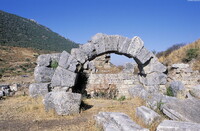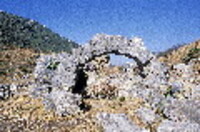| dc.coverage.spatial | Site: Ephesus, Aegean Region, Turkey | en_US |
| dc.coverage.temporal | ca. 100-300 CE (creation) | en_US |
| dc.creator | unknown (Ancient Roman) | en_US |
| dc.date | 100-300 | en_US |
| dc.date.accessioned | 2013-02-26T20:50:59Z | |
| dc.date.available | 2013-02-26T20:50:59Z | |
| dc.date.issued | 100-300 | en_US |
| dc.identifier | 196449 | en_US |
| dc.identifier.other | archrefid: 1566 | en_US |
| dc.identifier.uri | http://hdl.handle.net/1721.3/103960 | |
| dc.description | View of the baths, depicting arch; From the 2nd century AD onwards, gymnasia combining palaestras and baths occupied a large area of the city of Ephesos. Their strong walls and vaults made them expensive to build, and the large quantities of water needed to operate them had to be supplied through reinforced pipes. Surviving buildings include the Vedius Gymnasium, the Theatre Gymnasium, the 'East Gymnasium', the Baths of Varius (renovated in Late Antiquity by a certain Scholastikia) and the Harbour Gymnasium (all mainly 2nd to 3rd century AD). The most usual masonry for walls and vaults in the 1st century AD was rough stonework bonded with lime mortar. In the early 2nd century AD construction in brick began, using square bricks the size of a Roman foot. At the end of the 2nd century AD the bricks became larger, and broken bricks are also found in the opus caementum filling of the great walls of bath buildings. Stone masonry in conjunction with brickwork first occurs in Late Antiquity. [The mosaics in the 40 meter long corridor dates to the 5th century. It has three sections, frigidarium (cold water), tepidarium (warm water) and caldarium (hot water).] Source: Grove Art Online; http://www.oxfordartonline.com/ (accessed 7/13/2008) | en_US |
| dc.format.medium | marble; stone; brick | en_US |
| dc.rights | © Scott Gilchrist, Archivision, Inc. | en_US |
| dc.subject | architectural exteriors | en_US |
| dc.subject | domestic life | en_US |
| dc.subject | genre | en_US |
| dc.subject | Imperial (Roman) | en_US |
| dc.title | Baths of Varius | en_US |
| dc.title.alternative | Ephesus: Baths | en_US |
| dc.type | image | en_US |
| dc.rights.access | Licensed for educational and research use by the MIT community only | en_US |
| dc.identifier.vendorcode | 1A3-R-T-E-17-D2 | en_US |
| vra.culturalContext | Ancient Roman | en_US |
| vra.technique | construction (assembling) | en_US |
| vra.worktype | public bath | en_US |
| vra.worktype | excavation (site) | en_US |
| dc.contributor.display | unknown (Ancient Roman) | en_US |



